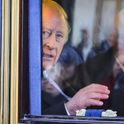Queen Elizabeth II can only be compared to Queen Victoria, whose subjects felt on her death that, as the poet Robert Bridges put it, “the keystone had fallen out of the arch of heaven.” When Victoria died, Arthur Balfour told parliament that “In all the history of the British monarchy there has never been a case in which the feeling of national grief was so deep-seated, so universal, so spontaneous.” This was fair comment. Londoners alone spent some £4m (in modern money) on floral tributes to the Queen-Empress. And when her bier, which was said to be too small to hold the heart of an Empire, passed on its processional route through the capital there came from the crowd, as John Galsworthy wrote, a strange, echoing sigh, “a mourning groan… unconscious, primitive, deep and wild.” It was the “Tribute of an age to its own death.”
These sentiments will be replicated, and doubtless augmented by social media, now we have reached the end of Queen Elizabeth’s record-breaking reign. This was longer by seven years than that of her great great grandmother, but it presented the crown with much graver difficulties. Queen Victoria became the mother of the nation when Britannia ruled the waves and ran the workshop of the world, a third of which was coloured red on the map. She was the champion of Balmorality when the Nonconformist conscience ruled the roost. And her position at the apex of the social hierarchy was sustained by a newly emergent popular press, which regarded royalty as good for the circulation.
Economic setbacks notwithstanding, this state of affairs seemed largely intact when the 27-year-old Queen Elizabeth was crowned in 1953. It was a golden moment in our annals, the most glittering spectacle of the century, which remains bright in the memories of those who witnessed it even on the tiny black and white television sets of the time. To those of us who were among them it appeared to symbolise the greatness of a nation (still led by Churchill) that had won the war, overcome socialist austerity, mounted the Festival of Britain, aspired to the moral leadership of the world and, as a bonus, had just conquered Everest.
After the ceremony Princess Margaret was seen to brush a piece of fluff from the uniform of a royal equerry, group captain Peter Townsend. The gesture alerted journalists to their romance, which was to present the monarch with her first major challenge. Haunted by the spectre of her uncle’s abdication and in deference to her position as Supreme Governor of the Church of England, the Queen set her face against her sister’s marriage to a divorcé. It was a stance that she was obliged to alter in due course, finally giving her seal of approval to our new Queen Consort Camilla.
Other challenges followed and Queen Elizabeth showed a remarkable capacity to meet them even though doing so went against the grain. She was instinctively conservative, the embodiment of tradition, disinclined to change anything but her clothes. Her ideal was to be a country lady surrounded by horses and dogs, and she had been educated as her mother had wished in “all the distinctively feminine graces.” Yet she undertook gradual modifications to the monarchy, cautious reinventions often disguised as forms of continuity. Never a weathervane, blown about by gusts of fashion, she was a barometer slowly responding to variations in the climate of opinion.
In 1957, for example, she was shocked (along with many of her subjects) by an article in which a Conservative peer, Lord Altrincham, said that she was surrounded by stuffy, tweedy courtiers and appeared hopelessly out of touch with her public. Yet Prince Philip himself agreed with the criticisms and the Queen reacted by abolishing snobbish, old-fashioned customs such as the presentation of debutantes at court. She also came to terms with television, though she hated the ordeal of her Christmas broadcasts.
Queen Elizabeth was also blamed for colluding with an aristocratic cabal to ensure that Alec Douglas-Home succeeded Harold Macmillan as prime minister. This was hardly unconstitutional, but the Queen made sterling efforts subsequently to demonstrate that she was a democratic sovereign. It was an almost impossible task: she had to be both ordinary and extraordinary; to be “just folks” and the gloved hand in the gold coach; to seem approachable while retaining the aura of majesty.
The erosion of deference during the 1960s, typified by Rupert Murdoch’s arrival in Fleet Street, made this role harder to sustain. Arguably the Queen erred in granting the BBC access to make the film Royal Family, which showed the icon with a human face and let daylight in upon magic. Certainly she prevented its being repeated afterwards, shunning anything intimate or remotely controversial in the interest of uniting her subjects (where Prince Charles sometimes divided them). Indeed, the Queen doggedly performed her public duties to the last, however awkward and distasteful they may have been—she must have been appalled, for example, at having to approve Boris Johnson’s illegal prorogation of parliament.
Queen Elizabeth fulfilled the lifelong commitment she made on her 21st birthday to serve “our great imperial Commonwealth,” giving substance to that Commonwealth even as the empire disappeared. While maintaining royal omertà, which will continue to obscure the full truth about her for years to come, she clearly preferred some of her prime ministers (Douglas-Home and Wilson) to others (Heath and Thatcher); but she gave them all, as Jim Callaghan said, friendliness if not friendship. With Prince Philip’s support, she did her best to sustain the ideal of a family monarchy despite the adulterous behaviour of younger royals. She faced her own annus horribilis in 1992 and overcame the trauma of Princess Diana’s death in 1997. She preserved an Anglican monarchy in a multicultural, multi-faith society. And despite a general discrediting of the hereditary principle, she successfully steered her erratic oldest son onto the throne.
“We all feel motherless today,” wrote Henry James on the demise of Queen Victoria. Many will share that sentiment now. Some may even echo what Queen Mary wrote about George V in 1936: “The sunset of his death tinged the whole world’s sky.”












